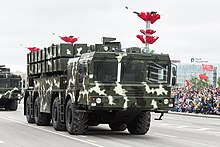Polonez (rocket launcher)
The Polonez ( Belarusian Паланэз Palanes , German 'Polonaise' , Russian Полонез ) is a Belarusian multiple rocket launcher system manufactured by BelSpetsVneshTechnika (BSVT). It is used to combat area targets. Alternatively, you can also write Polones .
development
The Polonez was developed to replace the obsolete Soviet multiple rocket launch systems 9K57 Uragan (caliber 220 mm) and 9K58 Smertsch (caliber 300 mm).
Polonez was developed in cooperation with the People's Republic of China and is based on the current Chinese artillery missile system A200 . In 2013, China supplied six A-200 missile systems as the basis for the Polonez missile launcher. Shooting attempts were also made later in China. Polonez uses the missiles of the A200 missile system. In 2015, the first Polonez were delivered to the Belarusian armed forces for troop evaluation . All tests are said to have been completed in 2016 and the Polonez was introduced in the same year for the 336th Missile Brigade .
Conception
The multiple rocket launcher system is manned by a three-man crew, consisting of a commander, driver and missile officer. The missiles can be fired either from the cab or from another vehicle using radio remote control . The loading vehicle is equipped with a hydraulic crane with which the rocket pods can be brought onto the launcher. The rocket launcher can perform both single and volley fire . A full volley of eight missiles can be launched within 50 seconds. It is possible to assign a separate target to each missile so that several targets can be fought at the same time. The Polonez is ready for action within eight minutes and should be able to adopt a new firing position in just two minutes to avoid counterfire.
A Polonez battery includes a mobile command post, 4–6 charging vehicles, 4–6 launch vehicles and a maintenance vehicle. In addition, the battery can be equipped with an unmanned aerial reconnaissance vehicle (UAV) for target acquisition and damage assessment.
variants
- V-200 Polonez: With eight A200 missiles per launch vehicle. Max. Shooting distance 200 km.
- V-300 Polonez-M: With eight A300 missiles per launch vehicle. Max. Shooting distance 280-300 km.
- V-300RK Polonez-M: With two M20 missiles per launch vehicle. Max. Shooting distance 280 km, warhead 480 kg
technology
Base vehicle MZKT-7930-300
The loading vehicle and the launch vehicle are based on the MZKT-7930-300 from the Belarusian manufacturer Minski Sawod Koljosnych Tjagatschei , which is powered by a JaMZ -846 turbo-diesel engine with a maximum engine output of 500 hp. The all-terrain 8 × 8 all-wheel drive vehicle is suitable for shoot-and-scoot maneuvers and has a payload of 22.4 tons. It is also equipped with a fully air-conditioned driver's cab that can accommodate the entire three-person crew. The MZKT-7930-300 has a tire pressure control system and reaches a top speed of 70 km / h on the road. On the rear axle pair of the launcher vehicle, the rocket launch containers are installed on a horizontally and vertically pivotable launcher arm. Eight starting containers are mounted on this in two layers.
Missiles
Polonez uses the missiles of the A200 missile system from the People's Republic of China. The A200 rockets have a caliber of 301 mm, are 7.26 m long and have a launch weight of 730–750 kg. The missiles are spin stabilized and have four stabilizing wings at the end of the missile. The missile will be guided to its target using GNSS and INS . As a result, a minimum circle error probability (CEP) of 30–45 meters should be achieved even at firing ranges of up to 300 km . The maximum firing distance is 200 km with a burn speed of Mach 4.5. The apogee here is 48,000 m. The minimum shooting distance is 50 km. The following warheads with a weight of around 150 kg are available for the missiles:
- A200 HE: fragmentation warhead
- A200 FRAG-HE: fragmentation warhead with pre-fragmented fragments
- A200 FSPC: cluster munitions
distribution
The first export of the Polonez system took place in 2018 to Azerbaijan , where a launch vehicle was seen on Armed Forces Day on June 26, 2018.
Individual evidence
- ↑ a b c d e Polonez Multiple Launch Rocket System (MLRS), Belarus (English)
- ↑ Belarus Security Blog: Polonaise with a Chinese accent. (English)
- ↑ a b Medium.com: Belarusian Polonez Multiple Launch Rocket System (English)
- ^ Trade Register on sipri.org , Retrieved July 23, 2019
- ↑ a b ADEX 2018: Army Recognition: Belarus continues delivery of Polonez multiple launch rocket systems to Azerbaijan (English)
- ↑ Belspetsvneshtechnika: “Polonez” To Be Equipped with Rocket of 300 km Range
- ↑ Jane's: Belarus to adopt extended-range missile for V-300 Polonez-M MRL system (English)
- ↑ Jane's: Belarus unveils upgraded Polonez-M MRL system (English)
- ↑ Defense Blog: New Belarus's missile can reach over 280 kilometers (English)
- ↑ VOLAT: MZKT-793000-300
- ↑ a b c d ALIT, China Aerospace Long-March International, Defense Product Catalog 2017: A200 Precision Guided Multiple Launch Rocket System. Pp. 26-27.
- ↑ Belarusian Ministry of Defense: Belarus Conducts Fire Test of Polonez MLRS
- ↑ belta.by: Belarus test fires long-range MLRS Polonez
- ↑ azeridefence.com: “Polonez” MLRS which was bought by Azerbaijan from Belarus was demonstrated (English)


